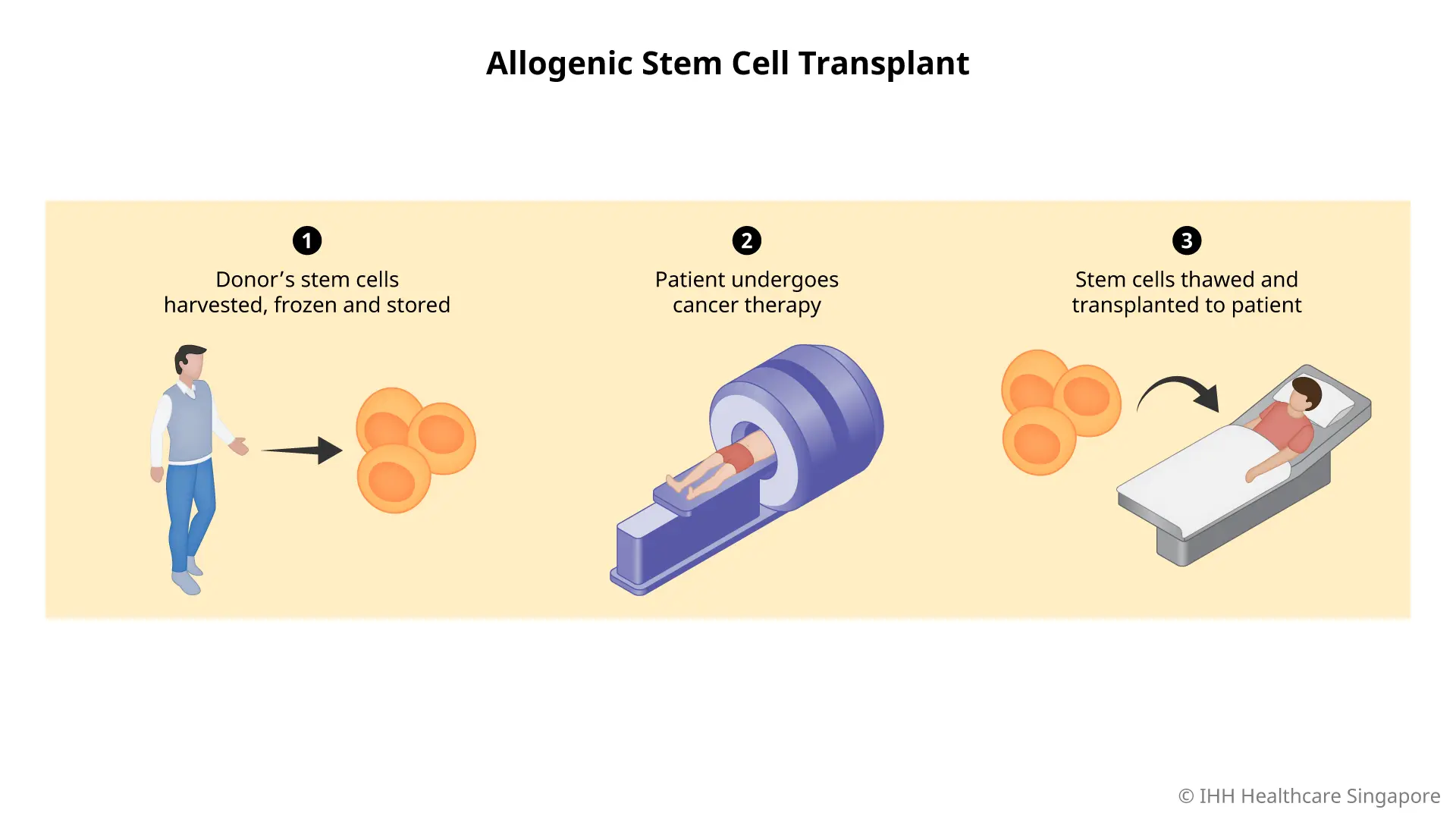-
-
Featured Care Areas

Allogeneic Stem Cell Transplant
What is an allogeneic stem cell transplant?
Allogeneic stem cell transplant is a procedure that transfers healthy donated stem cells to a patient whose own cells have been destroyed by radiation or chemotherapy.
'Allo' in allogeneic means the stem cells come from an 'other' person. The donor stem cells must have a genetic typing that matches the recipient's. Usually, donors come from a direct relation (such as a sibling).
If there is no familial match, compatible donors may be found through international bone marrow registries. Special blood tests are done to check for donor-recipient compatibility.
Stem cells can also come from the blood from the umbilical cords of newborns (cord blood) that has been stored. This type of treatment is mainly used for children as the number of stem cells in cord blood is not enough to treat adults.
Allogeneic vs autologous stem cell transplant
In an allogeneic stem cell transplant, you receive stem cells donated by someone else. In contrast, an autologous stem cell transplant uses our own cells, which means you are your own donor.
In this type of transplant, your stem cells are harvested (removed), frozen and stored before you receive your high-dose chemotherapy or radiation therapy treatment. After your treatment, your stem cells are thawed and returned back into you.
Why do you need an allogeneic stem cell transplant?
Allogeneic stem cell transplants are used to treat conditions such as:
- Hodgkin lymphoma
- Leukaemia
- Multiple myeloma
- Myelodysplastic syndrome
- Non-Hodgkin lymphoma
- Severe aplastic anaemia
- Testicular cancer
The advantages include the following:
- The donor stem cells produce their own immune cells, which may help destroy the cancer cells that remain after high-dose treatment.
- The donor can be recalled to donate more stem cells if needed.
The disadvantages include the following:
- The donor cells may be more likely to die or be destroyed by the recipient’s immune system before settling in the bone marrow.
- The donor cells may create new immune cells that attack the recipient’s body, a condition known as graft-versus-host disease (GvHD).
- A small risk of infections from the donor cells (although donors are tested beforehand to minimise this risk).
What are the risks and complications of an allogeneic stem cell transplant?
The side effects of a stem cell transplant may vary from person to person. Some individuals experience multiple side effects, while others may have fewer. Some side effects are short-term (acute), while others are long-term (chronic).
Many of the side effects result from the chemotherapy or radiation therapy given before the transplant. Others are related to the stem cell transplant.
Initial side effects can include:
- Mouth and throat pain
- Nausea and vomiting
- Bacterial, viral or fungal infections
- Bleeding and anaemia (low red blood cell count)
- Graft-versus-host disease (GVHD), which happens when the donor immune cells see your body as foreign and the cells attack certain organs
- Lung problems such as pneumonitis, an inflammation of lung tissue
- Veno-occlusive disease (VOD), when small blood vessels that lead to the liver become blocked
Longer-term side effects can include:
- Eye problems such as cataracts
- Organ damage
- Return of the cancer
- Secondary cancers
- Lymph tissue problems
- Infertility
- Thyroid problems caused by hormone changes
After your stem cell transplant, your doctor will monitor you closely. They will take measures to prevent side effects and to quickly deal with any that develop.
Why choose Parkway East Hospital?
Parkway East Hospital is the preferred private hospital for residents in the eastern coast of Singapore for the treatment of different cancers.
Our fully-equipped hospital provides patients undergoing cancer treatment with a conducive environment for a comfortable and smooth recovery.
You will be well-supported by our team of caring nurses, counsellors and therapists who will be there for you through your cancer treatment journey.
Estimated cost
Private healthcare can be affordable. Use our Hospital Bill Estimator to determine the estimated cost of this procedure. If you have hospital insurance, find out how you can use your insurance.
Find doctors from our allied hospitals
We offer a full spectrum of healthcare services under IHH Healthcare Singapore.
Check if your preferred hospital offers this treatment:
This page has been reviewed by our medical content reviewers.
Need help?
For enquiries, please call
+65 6377 3737
For appointment bookings, please WhatsApp
+65 8111 3777




